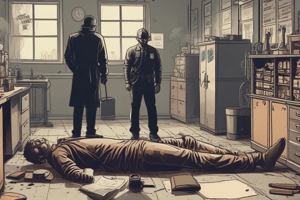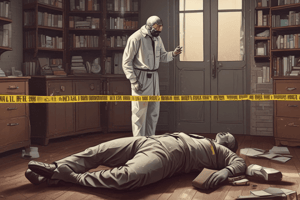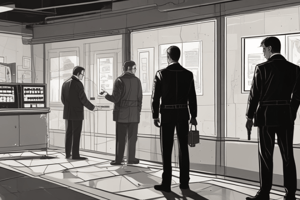Podcast
Questions and Answers
Qual é o principal objetivo da análise forense?
Qual é o principal objetivo da análise forense?
- Identificar a fonte da evidência e estabelecer um link com o suspeito ou vítima (correct)
- Documentar a cena do crime com fotografias e notas
- Coletar e preservar evidências físicas
- Reconstruir a cena do crime
O que é fundamental para a reconstrução da cena do crime?
O que é fundamental para a reconstrução da cena do crime?
- Testemunhos oculares
- Evidência física coletada no local (correct)
- Fibra e análise de pinturas
- Análise de substâncias químicas
Qual é o principal objetivo da investigação da cena do crime?
Qual é o principal objetivo da investigação da cena do crime?
- Preservar e documentar a cena do crime (correct)
- Identificar a fonte da evidência
- Estabelecer um link entre a evidência e o suspeito
- Reconstruir a cena do crime
Quais desses é um exemplo de coleta de evidência biológica?
Quais desses é um exemplo de coleta de evidência biológica?
O que é feito durante a reconstrução da cena do crime?
O que é feito durante a reconstrução da cena do crime?
Qual é o objetivo da coleta de evidências físicas?
Qual é o objetivo da coleta de evidências físicas?
Qual é o papel principal de um perito forense?
Qual é o papel principal de um perito forense?
Quais tipos de análise forense existem?
Quais tipos de análise forense existem?
O que é o objetivo principal da análise química?
O que é o objetivo principal da análise química?
Qual é o princípio fundamental da coleta de evidências?
Qual é o princípio fundamental da coleta de evidências?
O que é feito durante a coleta de evidências?
O que é feito durante a coleta de evidências?
Quais tipos de evidências são coletadas?
Quais tipos de evidências são coletadas?
Qual é o objetivo da análise forense?
Qual é o objetivo da análise forense?
O que é o registro de evidências?
O que é o registro de evidências?
Flashcards are hidden until you start studying
Study Notes
Forensic Expert's Role
Forensic Analysis
- Examination of physical evidence to determine its relevance to a crime
- Includes:
- Chemical analysis of substances (e.g. drugs, toxins)
- Biological analysis of bodily fluids (e.g. DNA, bloodstains)
- Physical analysis of materials (e.g. fibers, paints)
- Goals:
- Identify the source of the evidence
- Determine the relevance of the evidence to the crime
- Establish a link between the evidence and the suspect or victim
Scene Reconstruction
- Reconstruction of the crime scene to understand the sequence of events
- Based on:
- Physical evidence found at the scene
- Witness statements
- Other available information
- Goals:
- Establish the timing and sequence of events
- Identify the actions of the perpetrator(s)
- Reconstruct the crime scene to aid in the investigation
Crime Scene Investigation
- Systematic and thorough examination of the crime scene
- Includes:
- Documentation of the scene (e.g. photographs, notes)
- Collection of physical evidence (e.g. fingerprints, footprints)
- Observation of the scene for potential clues
- Goals:
- Preserve and document the crime scene
- Collect and preserve physical evidence
- Identify potential leads and areas for further investigation
Evidence Collection
- Systematic and careful collection of physical evidence
- Includes:
- Collection of biological fluids (e.g. blood, saliva)
- Collection of physical materials (e.g. fibers, hairs)
- Collection of digital evidence (e.g. computer files, emails)
- Goals:
- Preserve the integrity of the evidence
- Ensure the chain of custody is maintained
- Ensure the evidence is suitable for analysis and comparison
Studying That Suits You
Use AI to generate personalized quizzes and flashcards to suit your learning preferences.




